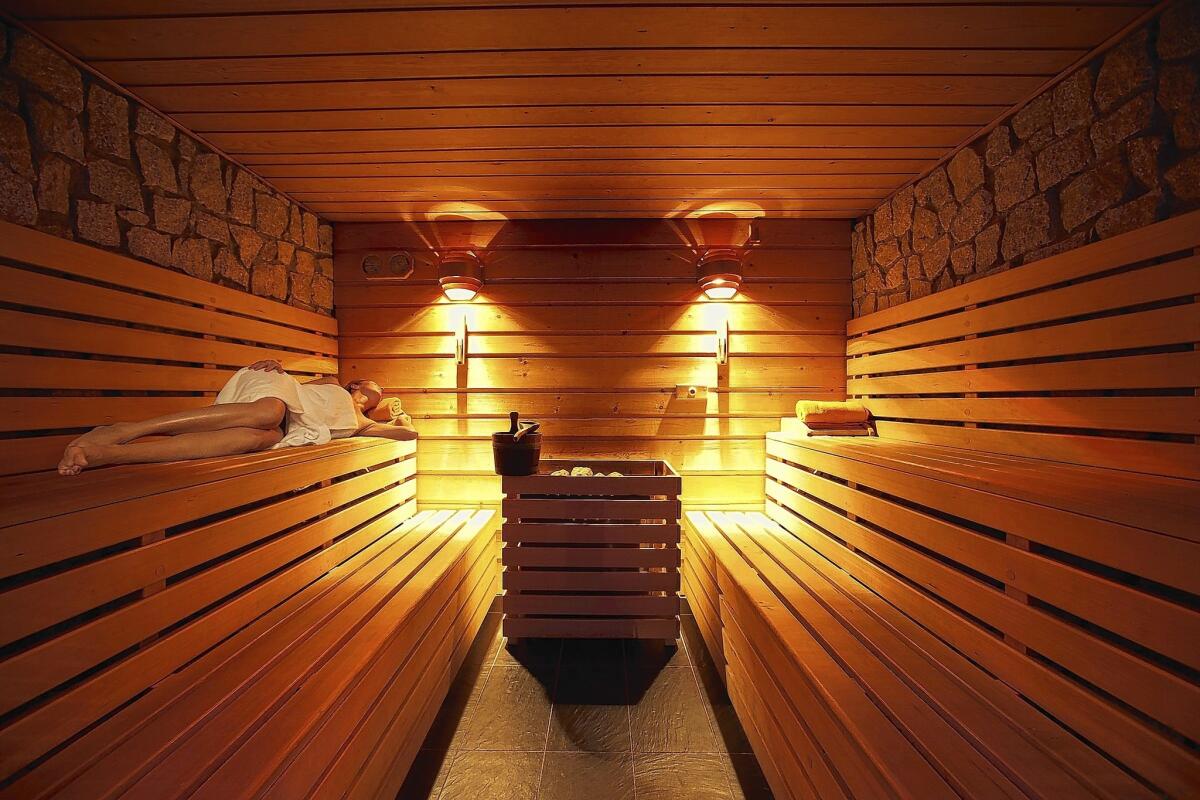Hot tips from a summit of sauna experts

- Share via
The Greek physician Hippocrates may well have been the first sauna aficionado. One can imagine him, circa 400 BC, sitting in a tiny windowless room heated by hot rocks, sweat dripping down his brow, proclaiming, “Give me the power to create a fever, and I shall cure any disease.”
But even the father of modern medicine would have learned a thing or two at a first-of-its-kind Perfect Sweat Summit in March that brought together about 60 like-minded international sauna experts, all sweating out the small stuff — and the large — in a Russian sauna spa (or banya) overlooking San Francisco Bay.
The summit was organized by San Francisco photographer and author Mikkel Aaland, a Norwegian American whose 1978 book, “Sweat,” is still considered the definitive history of sweat bathing around the world; Greg Moga, a Seattle entrepreneur and sauna devotee who acquired the rights to turn Aaland’s book into a documentary; and Mikhail Brodsky, president of Lincoln University in Oakland, who spent 10 years building his dream authentic Russian spa called Archimedes Banya.
Academics, psychologists, authors, spa owners and authorities, sauna society presidents, sauna builders, a guy named Barefoot Ted and others came from Finland, Canada, Russia, Minnesota, Oregon, Washington state, San Francisco and elsewhere to discuss and debate the practicalities, psychology, physiology, spirituality and marketing of a millennia-old ritual that the American spa movement seems to have marginalized as a minor amenity.
Gleaning the wisdom of this esteemed body of experts, who collectively have taken tens of thousands of sweats over their lifetimes, herewith are some of their tips to enhance the experience for neophyte and seasoned sauna enthusiasts (and don’t forget to consult your physician before taking the plunge):
1. A good sauna starts with proper heating and dimensions. Risto Elomaa, president of the International Sauna Assn. and a native of Finland, calls saunas heated with infrared units “glorified bread toasters.” According to specifications outlined by an ISA task force in 1999, an authentic sauna contains stones heated by forced hot air or wood (he calls the wood-heated saunas the “Ferraris of saunas”). The bench should be a maximum of 3.5 to 4 feet from the ceiling. The Finnish Sauna Society suggests temperatures from 176 to 194 degrees. A minimum of 150 degrees is important; below it, bacteria will be fruitful and multiply.
2. Consider the sauna a spiritual ritual — so, no cellphones. And just as when you enter a church, mosque, cathedral, temple or synagogue, it’s respectful to others — and yourself — to be as quiet as possible.
3. Go naked and be not ashamed. Many, if not most, Americans think it’s taboo to wear their birthday suits in public, especially in mixed company — even in a sauna. In Europe, many families sauna naked together without hang-ups.
4. Take the time. Leave a solid two to three hours to absorb and integrate the full gestalt of the experience. This will entail a cycle of three hot-to-cold repetitions. After a quick shower to rinse off the day, spend 12 to 20 minutes in the sauna. Follow this by a cold plunge into a cool pool of 5 seconds to whatever you can stand. From there, hit a Jacuzzi or steam room, if there is one, or simply relax at room temperature for about 15 to 20 minutes. Repeat the cycle two more times. Devoting this much time may be the hardest part of sauna for the typical American, but there’s a huge payoff to continued and repeated sweats, said Jarmo Lehtola, head of the Finnish Sauna Society, a country with 5 million people and 3.2 million saunas. The multiple benefits of sauna have been reported in such professional publications as the American Journal of Medicine and the Alternative Medicine Review.
5. Now take the plunge. If you are not a Finn, it may take more than empirical evidence to make you race buck naked across frozen tundra and leap into an ice pond — or, in most others’ cases, scurry in a towel across the spa from the sauna to slip into the cold pool. It requires a leap of faith that this seemingly masochistic act is good for your body and a most beneficial way to finish a sauna. But for those of little faith, psychologist Stephen Colmant of New Mexico, author of “Sweat Therapy: A Guide to Greater Well-Being,” offered this: A post-sauna dunking into waters of 45 to 55 degrees reduces pain and inflammation, and improves allostatic functioning — the body’s ability to achieve stability (or homoeostasis) through physiological or behavioral change, to “roll with life’s punches,” as he put it — through the activation of neural, hormonal and immunological mechanisms. On a more psychological level, he added, “Through such submission and ordeal, one becomes humbled, and wiser. We experience a kind of death and rebirth, and a deeper understanding of our limits and our potential.”
6. Become mindful in the sauna. Sean Mullen, assistant professor of kinesiology and community health at the University of Illinois, calls it “purposeful sweating.” “Have a goal in mind,” Mullen said, “something you want to think about, process, resolve, forget. When you enter the sauna, you have two choices: Be passive and allow your mind to wander, or attend to the heat and what ails you. The former will probably allow you to stay in there longer, as studies of endurance athletes have shown.”
More to Read
Sign up for The Wild
We’ll help you find the best places to hike, bike and run, as well as the perfect silent spots for meditation and yoga.
You may occasionally receive promotional content from the Los Angeles Times.






